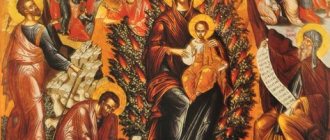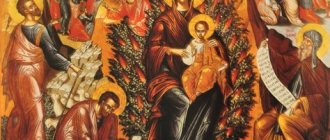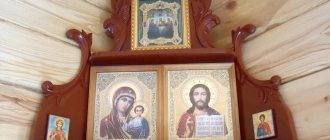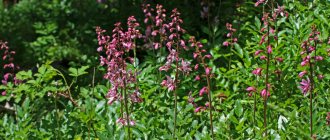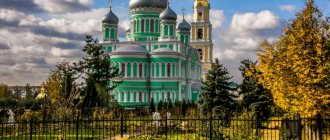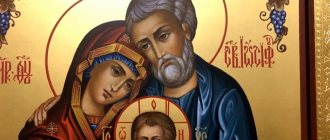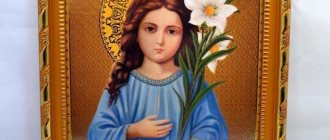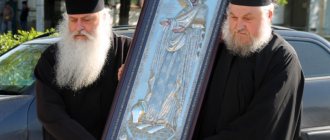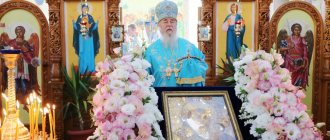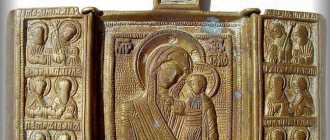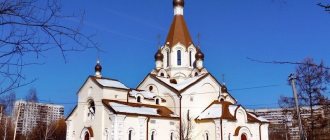Burning bush bush
Hermitage in the Sinai mountains
View of the bush
Prophet Moses
A lot has been written about what the burning bush is, but most of the information is presented preserving Old Slavonic words and sentences, which are very different from modern speech and are not always understandable. We present to you an overview of what the burning bush is, compiled in simple words accepted today in colloquial and literary speech.
What is the Burning Bush
According to the description of the second book of the Pentateuch (Torah) - “The Burning Bush” is the ancient name of a thorn bush or blackberry in the fire of which God appeared to the prophet Moses. Moses, then wandering through the desert, being at the foot of Mount Sinai, on the slope of the mountain saw a thorn bush burning with a bright flame.
Seeing this unusual phenomenon, Moses came closer, and God appeared before him in the fire of a burning thorn bush and from the fire of a burning bush ordered Moses not to approach the place of the miraculous phenomenon and to take off his shoes. After which the Lord called Moses to serve the Jewish people, who were living in slavery to the Egyptians at that time, for which he had to lead the Jewish people from Egypt to the Promised Land.
Where are the priceless icons of the Blessed Virgin Mary kept?
Many priceless ancient icons were lost during the Soviet period. The following places for storing icons are known:
- Kremlin (Moscow), Annunciation Cathedral - the first shrine brought by monks from Palestine back in the fourteenth century;
- Cathedral of Peter and Paul - in the Ural village of Suksun;
- Church in Sosnovy Bor (in the Leningrad region);
- Holy Mother of God Neopalimovsky Cathedral, Ulyanovsk - this shrine was written in the last century.
Who is Moses
According to the Holy Scriptures, Moses was the son of the Jewish family of Amram and Jochebed; he was born around 1570 BC. At that time, the Israelis had already lived in Egypt for almost 400 years and, thanks to their intelligence and hard work, were quite wealthy people and their number gradually increased, there were almost a million Israelis at that time. The Egyptian pharaoh, fearing that the Jews could become a large nation, made the Jews state slaves, and moreover, he gave the order to kill all newborn Jewish boys. Moses' mother Jochebed, in order to save her son, hid him in a basket and floated it along the waters of the Nile.
The floating basket was seen by the daughter of Pharaoh, who loved to swim in the Nile, and when she heard crying, she saved the baby from death. And although she guessed that there was a Jewish baby in the basket, she took him to the palace and raised him as her son. Moses grew up among rich and noble people and was trained as their equal.
When he was already forty years old, one day, having seen how an Egyptian overseer mocked working Jews, he killed the overseer in anger. And so as not to be punished for this, he fled into the desert.
While wandering near one of the wells, he met Zipporah and her sister, the daughters of a priest, for whom he interceded with the shepherds who did not allow them to draw water.
In gratitude for this, her father invited Moses to stay and live in their house. Zipporah became his wife and soon they had a son, Gersham. Moses was busy tending the sheep of Jethro, the priest of Midian, his father-in-law, and one day he found himself near Mount Sinai, where he saw a burning thorn bush.
How to grow?
Burning bush is a plant that can be propagated by sowing seeds in spring and autumn, dividing a bush, or in spring, by cuttings with a “heel”.
Despite the fact that ash can self-sow, the germination rate of its seeds is rather weak. Flower growers note that sometimes when sown in winter they germinate only after a year. Small seedlings that have sprouted from seeds are transplanted into mini-greenhouses or small boxes, leaving 10-15 cm between plants. In such conditions, seedlings are grown for three years, after which they are planted in a permanent place. Such plants will bloom in a few years. The easiest way to propagate ash is by dividing an adult bush in spring or autumn. The seedlings obtained in this way take root better and begin to bloom earlier.
What Moses saw at the Burning Bush
One day, when Moses was tending a flock of sheep, he came to Mount Horeb, as Mount Sinai was then called. Not far away, on the mountainside, they saw a thorn bush with a flame blazing above it, but for some reason the fire did not burn the branches of the bush. Interested in this unusual phenomenon, he came closer.
And then Moses heard a voice proclaiming to him:
- Moses! Moses!
Moses replied:
- Here I am.
- And a voice said to him: I am the God of your father, the God of Abraham, the God of Isaac and the God of Jacob. Do not come here, but first remove your shoes from your feet, for the place on which you stand is holy ground.
Moses hastily took off his shoes and covered his face, because he was afraid to look at God.
And God called to him from the flame of the bush:
“I know about the suffering of my people in Egypt; their cry of sorrow and request for help reached me. I say to you: go back to Egypt to Pharaoh, go there and lead my people, the children of Israel, out of Egypt.
Prayers to the Blessed Virgin
Prayers to the Virgin Mary, like any other prayers, must be sincere and carry exclusively good intentions. The best way to ask is to protect, preserve, heal, help, prevent, protect. Requests can be personal in nature, relating to family matters, the lives of relatives and friends.
Archimandrite Photius Spassky compiled a special service in honor of the “Burning Bush”.
Troparion, tone 4
Who in the fires of the unburnt bush, seen in ancient times by Moses, / Who foreshadowed the mystery of His incarnation from the Virgin Mary who was not made of art, / Even now, as the Creator of miracles and of all creation, / Her holy icon glorified many miracles, / bestowing it on the faithful for healing from illness and for protection from fiery ignition./ For this sake, we cry out to the Most Blessed One:/ The hope of Christians, deliver those who trust in You from severe troubles, fire and thunder, and save our souls as the Merciful.
Troparion, tone 4
Who in the Bush, with fire burning and incombustible,/ showed Moses Your Most Pure Mother, O Christ God,/ the fire of the Divinity was not consumed in her womb/ and remained incorruptible at Christmas,/ by whose prayers delivered us from the flames of passions/ and preserved Thy city from the fiery incinerations, / like the Most Merciful.
Kontakion, tone 8
Let us purify the feelings of our souls and bodies, so that we may see the Divine Mystery, / figuratively revealed in ancient times to the great prophet Moses, with a bush that burned with fire and was not consumed, / in it, O Mother of God, we confess the foretelling of Your seedless Nativity and, reverently worshiping You and the Savior Who was born of You ours, / crying out in fear: Rejoice, Lady, Protection, Refuge, and Salvation of our souls.
Prayers to the Burning Bush icon
“To the Queen of Heaven, our Lady, Lady of the Universe, Most Holy Theotokos, undefiled, unglamorous, imperishable, most pure, pure Ever-Virgin, Mary Bride of God, Mother of the Creator of creation, Lord of glory and Lord of all! Through you the King of kings and Lord of lords has come and appeared to us on earth. You are God's mercy incarnate. You are the Mother of Light and Life, just as you once carried Him in Your womb and in Your arms You had the Child, the Word of the Eternal, God, and so you have always carried Him with You. For this reason, according to God, we resort to You, as if to an unbreakable wall and intercession: look with mercy, all-sung Mother of God, on our fierce bitterness and heal our souls and bodies of illness: drive away from us every enemy and adversary, deliver from hunger, pestilence, and ulcers , from many waters and harmful airs, and from sudden death; and like the three youths in the cave of Babylon, preserve and keep us, so that, like the people of God of old, all good things will come to us who honor Thee; Let all those who hate us be ashamed and put to shame, and everyone will understand that the Lord is with You, O Lady, and God is with You. In the days of autumn, bring us the light of Thy grace, and in the darkness of night, enlighten us with light from above, making everyone useful: turn our sorrow into sweetness and the tears of the morning of Thy servants who have sinned and are in need, who fulfill every request for the good; You can do everything you want, Mother of the Word and Life. The Father has crowned the Daughter, the Son has crowned the Virgin Mother, the Holy Spirit has crowned the Bride, so that you may reign like a queen, standing at the right hand of the Holy Trinity, and have mercy on us as you wish, now and ever and unto ages of ages. Amen".
“Oh, Most Holy and Most Blessed Mother of our Sweetest Lord Jesus Christ! We fall down and worship You before Your holy and most honorable icon, with which You have performed wondrous and glorious miracles, saving our homes from fiery flames and lightning thunder, healing the sick, and fulfilling every good request of ours for the good. We humbly pray to You, O omnipotent Intercessor of our race, to grant us the weak and sinners Your maternal participation and care. Save and preserve, O Lady, under the shelter of Your mercy, the Holy Church, this monastery, our entire Orthodox country, and all of us who fall before You with faith and love, and tenderly ask with tears for Your intercession. She, the All-Merciful Lady, have mercy on us, overwhelmed by many sins and not having boldness towards Christ the Lord, ask Him for mercy and forgiveness, but we offer to You for supplication His Mother in the flesh: But You, All-Good One, stretch out Your God-receiving hand to Him and intercede for us before His Goodness, asking us for forgiveness of our sins, a pious, peaceful life, a good Christian death, and a good answer at His terrible Judgment. At the hour of the terrible visitation of God, when our houses are set on fire, or we are frightened by lightning thunder, show us your merciful intercession and sovereign help: may we be saved by your omnipotent prayers to the Lord, the temporary punishment of God here, and we will inherit the eternal bliss of paradise there: and with everyone let us sing to the saints the Most Honorable and Magnificent Name of the worshiped Trinity, the Father and the Son and the Holy Spirit, and Your great mercy to us, forever and ever. Amen".
Forty years of wandering
At the command of God, Moses returned to Egypt and, after many ordeals, led the Israeli people out of Egypt. 600 thousand Israelites left Egypt with Moses, but since Moses did not know where to go, three months later they again came to Mount Sinai, where Moses saw the burning bush. The Israelites camped at Mount Sinai for about a year, and Moses was at the top of the mountain all this time. It was at this time that he wrote his famous Pentateuch. And it was there on the top of the mountain that God again appeared to Moses and handed him the tablets with the Ten Commandments, which he brought to the people.
For a long time Moses led the Jews through the desert. Years of wandering caused numerous disturbances, murmurs and uprisings of the people, for which the Lord punished and condemned them to a 40-year wandering.
And only forty years later the Israelis came to the land of Canaan, where Lebanon, Syria, Palestine and Israel are located today. They settled on the land of what is now Palestine and Israel, but not all of them, many scattered around the world.
Botanical features
Burning bush is a plant of the Rutaceae family with an extensive root system and beautiful flowers.
The slightly pubescent slender stem of this perennial ornamental flower can grow up to 1.5 meters. The leaves of the ash tree are medium-sized and usually imparipinnate. The upper part of the stem and leaves are densely covered with special glands that secrete strong-smelling essential oils. The racemose inflorescences of the burning bush come in different colors, from light pink to violet-lilac. Each five-petaled flower is decorated with blue-violet or red veins. The ash tree blooms closer to mid-June - in July, and this can be recognized by the bright and not very pleasant “pharmacy” smell that spreads throughout the entire district. In August, the plant's fruits already ripen and fall, smelling of freshly ground cinnamon.
Veneration of the burning bush
The holy appearance of the burning bush did not remain forgotten. In the 4th century, hermits began to settle near Mount Sinai, and on the slope of the mountain, where that same thorn bush, called the burning bush, grew, they built a chapel. In 324, the Mother of Emperor Constantine, Saint Helena, at the request of the monks, ordered the construction of a chapel on this site - a chapel, around which over time a monastery was built, which was called the “Monastery of the Burning Bush”.
Dorothea, the daughter of one of the noble people of Alexandria, who was named Catherine at baptism, was buried near the Monastery. Three centuries later, the monks discovered her remains and transferred them to the temple at the monastery. Catherine was canonized and her relics are kept in the monastery. In the 11th century, all Christian humanity learned about the location of the relics of St. Catherine; the monastery of the Burning Bush became a place of pilgrimage for a huge number of believers. And then the Burning Bush Monastery was renamed the Monastery of St. Catherine in her honor.
The main shrines of the Monastery of St. Catherine are the Burning Bush bush and the relics of the Holy Great Martyr Catherine. The monastery houses the Church of the Transfiguration, behind the altar of which, above the roots of the Burning Bush, is the Chapel of the Burning Bush. The Burning Bush bush itself was transplanted a few meters from the chapel, where it still grows today. The altar of the chapel is not covered by the iconostasis, so all pilgrims can see the hole in the marble slab covered with a silver shield, the place where Kupina used to grow. Pilgrims can enter the chapel, but first remove their shoes. The Burning Bush itself can be seen from the outside of the chapel.
The Burning Bush is revered not only by Christians. Muslims also consider Mount Sinai and the location of the bush to be sacred. It is believed that the Prophet Muhammad himself patronized the monastery, so in the 9th century a Muslim mosque was built in the monastery, which became the protection of the monastery from Muslim attacks and protected it from destruction. In the 12th century, a Catholic chapel was built in the Monastery. Catholics founded a special knightly order that provided assistance to pilgrims going to the monastery.
Features of care
Burnt bush grows well both in the sun and in the shade, is resistant to drought and undemanding to soil. The plant “refuses” to grow and bloom only in very shady places, as well as on waterlogged soils. This flower needs to be watered very rarely in the middle zone.
When choosing a place for planting, you must remember that the ash tree will demonstrate all its beauty in a sunny place protected from northern winds, best of all - in the eastern or southern elevated area of your garden. This flower has no special requirements for the composition of the soil; the main thing for it is good drainage and the absence of excess water. A bush can grow in one place for about 10 years. The burning bush is a plant whose care is somewhat unusual for us: you don’t need to water it, you can fertilize it, but only in very small doses. The plant overwinters well, but in particularly harsh or snowless winters it is better to cover it with spruce branches or leaves.
Icon of the Mother of God “Burning Bush”
The Icon of the Mother of God “The Burning Bush” is one of the most revered icons. Today there are several versions of this icon, painted at different times, but the oldest, painted by an unknown icon painter, was presented as a gift to the Russian people in 1390 and is located in the Moscow Kremlin, in the Annunciation Cathedral.
In the center of the icon is an image of the Mother of God and Child. This image is enclosed in an eight-pointed star formed by two quadrangles - green and red. Around are images of Old Testament scenes: Moses before the Bush, Jacob's dream, Ezekiel's Gate and the Tree of Jesha. Another theme of the icon is the service of the angels to the Mother of God and the worship of the heavenly powers to the miraculous birth of God from the Virgin - their images are located in the rays of an eight-pointed star; among them are archangels and nameless angels - personifications of the elements. It is believed that this icon saved Moscow from complete destruction as a result of a fire during the war with Napaleon. Since then, the Burning Bush icon has been considered a protector of housing and people from fire. Russian firefighters call the “Burning Bush” their patroness and intercessor.
One of the most famous icons, “The Burning Bush,” from the late 18th century, is located in the Epiphany Cathedral. At the bottom of the icon are the words from the troparion and the date of its renewal: “The imams do not provide any other help. The imams have no other hope, except for You, the mistress. Help us, we rely on You and boast in You. We are your slaves. Let us not be ashamed. Resumed on April 1835, 2nd day.”
Another Icon, “Our Lady of the Burning Bush,” from the late 16th century, is located in the Solovetsky Monastery. They claim that it was this icon that helped the Gulag prisoners in Solovki to survive, some of whom, even after liberation, took monastic vows and remained in the Monastery.
History of the icon
The first known images of the “Burning Bush” type appeared at the beginning of our era. The earliest image that has survived to this day is an illustration for the manuscript of the Byzantine Cosmas Indikoplov, now carefully preserved in the Vatican.
It is noteworthy that the original image was more plot-based and simpler to perceive: the Mother of God (usually Oranta), ascending above a burning bush, Moses bowed in reverence. But by the 16th century, the icon acquired a different, much more complex appearance, theological symbolism and many layers of meaning.
In one of the churches of the Chora Monastery in Istanbul, there is a well-preserved fresco depicting the Virgin Mary in a burning bush. And this despite the fact that this temple was a mosque for many centuries!
The first “Burning Bush” came to Rus', most likely, from the East, sometime in the 14th century. It quickly gained popularity because of its “fire-fighting” effect: the houses of our ancestors were wooden and often suffered from fires. Sometimes entire cities burned out!
The “Burning Bush” gained popularity, first of all, among ordinary people: it was present in almost every home iconostasis. People didn’t really understand the numerous layers of meaning – the main thing was that the image protected it from fires. And he sometimes performed true miracles!
This icon was further popularized with the invention of chromolithography. Colorful tin icons from Jacob Jacot were inexpensive, but they were amazingly durable and “elegant” - in a word, an ideal option for the common man.
And now the “Burning Bush” can often be seen in village houses. Moreover, it is often hung not in the “red corner”, but directly above the front door, to protect the home from all troubles.
Chromolithograph of the Burning Bush
Burning bush - a plant that burns but does not burn out
In many mountainous rocky places in Europe and Asia grows an unusual shrub whose Latin name is Dictamnus, a small genus from the Rutaceae family. Named after one of the mountains on the island of Crete. In Russia, this shrub is more often called “ash tree,” although the popular name for this plant is “Burning Bush.” Ash tree is a herbaceous perennial with powerful woody roots going deep into the ground. The height of the bush is 60-80 cm, sometimes up to 1 meter, the diameter of the bush is about 1 meter. Blooms in late June - early July. Stands out among others for the beauty of its flowers. But when burned, the burning bush has a sharp unpleasant odor, reminiscent of the smell of medicine or orange peel. There are several types of ash, this is what it looks like growing in the Far East.
It is named so because of its unusual and interesting feature, which is that if on a windless day you bring a lit match to the flowers and fruits of this plant, a short-term flame will flare up above them with a distinct pop, and the plant itself will not be affected by this fire. suffers.
They say that on a hot sunny day, fire can appear on its own from the rays of the sun. But in our relatively cool and humid climate, this can be seen very rarely. But in the Caucasus, where the white Caucasian ash tree grows, this phenomenon can be observed.
The fact that fire can occur above this plant is quite simply explained from a scientific point of view. The thing is that this plant secretes essential oils in large quantities, which in hot weather intensively evaporate from its flowers and fruits. This is most pronounced during the period of seed ripening. Other popular names for this shrub are wild star anise, volcana, ash tree, bodan, ash tree, bergenia, but it is better known as burning bush. It received this name because there is an opinion that this is the same burning bush bush mentioned in the Old Testament.
The burning bush looks like a beautiful flower, but it is very dangerous for humans. The essential oils that the ash tree produces are poisonous. If you pick them up while the fruits are ripening, you can get severe poisoning. At first you won’t feel anything, but the next day the temperature will rise, accompanied by severe weakness on your hands and there will be a burn with blisters and blisters. The burn does not go away for a long time and even after healing, scars remain. Severe skin damage over a large surface is life-threatening. Therefore, when you see such a bush, do not approach or touch it, or better yet, do not even breathe near it.
The burning bush in the fire of which God addressed Moses is one of the Old Testament symbols associated with the prototype of the Mother of God. The main message of the burning bush is the miracles of God, which are also manifested in the modern world; they are quite real and tangible. The burning bush is engulfed in flames, but remains intact and is only cleansed by the blessed fire. The presence of this symbol has a beneficial effect on every person. If you have the opportunity to visit the monastery of St. Catherine, being at the Burning Bush bush, be sure to make a wish and it will certainly come true.
Description of the image
On such icons of the 4th century, a fiery bush was depicted, in the center of which the face of the Virgin Mary was depicted. This is the most common version of the image of the Virgin Mary with a baby in her arms - the way the Evangelist Luke wrote it. Art historians believe that such an image conveyed a conversation between Christ (on such a shrine he looks not like a baby, but a youth) with the Mother of God. It was in this form that the icons were brought by pilgrims.
During the reign of Ivan the Terrible - already in the 6th century - fresh, very significant details began to appear in such icons. Rus' then actively annexed new territories - Siberia, Kazan, and so on. It was during this period, under Metropolitan Macarius, that theological texts appeared on the lists.
The icon has become an akathist; it calls for the glorification of the Virgin Mary, as if gathering around her everything that is in the world - here is the vault of heaven, and the earth, and natural and elemental forces. Cross diamonds appear on the lists - red and blue (green) colors. These rhombuses make it clear to modern people how people then saw the structure of the universe. The flaming red rhombus is the earth, the blue one is the vault of heaven, and above are the Heavenly Forces. And above everything that exists in this world is Jesus Christ.
At the same time, rhombuses also carry another meaning: red is fire, blue is a flaming bush. The evangelists are written in the protruding corners of the red diamond. It turns out that earthly fire engulfs heavenly fire, but cannot do this. That is, protection from the flame is faith and prayer.
Over time, the icon gradually becomes very difficult to interpret, but this is its mission - to attract attention with numerous images of the Orthodox faith, showing its grandeur, greatness and power.
Various symbols appear on the Burning Bush, conveying the history of faith. So, in the hand of the Virgin Mary is a ladder. This is an allusion to the vision that came to the prophet Jacob, who saw a ladder - the path from earth to Heaven.
In the corners of the red rhombus, figures of the evangelists can be depicted - in the form of a lion - Mark, a human figure - Matthew, an eagle - John, a calf - Luke, described in the Apocalypse.
The forces of Heaven, angels of various elements, subordinate to the Mother of God, are located in her immediate surroundings. Angels carry additional symbolic objects.
In the corners of the shrine there are images containing information about the visions of the prophets. So, at the top right is Isaiah’s vision of Seraphim holding a blazing coal. At the top left is the burning bush that Moses dreamed of. The lower left corner may show Ezekiel with the gates closed, and the lower right corner may show Jacob's vision of the ladders with angels.
Each figure or object depicted on the icon carries a certain, very important semantic load, has an individual theological explanation and denotes a phenomenon or a certain force, either on a material or on a spiritual level. The color scheme prevails is that described in the biblical text. If we describe the meaning of the icon in a few words, then it can be expressed by the following concepts - Incomprehensibility, God's Mystery, Goodness, Omnipotence, Mercy, All-vision.
The eight-pointed star is clearly visible on the canvases of icons, denoting the Bethlehem or Christmas Star. After all, there is historical evidence that at the moment of the birth of Jesus Christ, a star lit up in the sky - as a bright sign that the coming of Christ took place in earthly life. It was the Star of Bethlehem, according to the Gospel, that helped guide the Magi as they went with gifts to bow to the Son of God.
Christianity
A prototype, like the three youths in the fiery furnace, of the virginity of the Virgin Mary.
Among the church fathers and in church songs, this vision is given a mysterious meaning: the burning, but not consumed bush is the Mother of God, who remained incorruptible even after the incarnation and birth of the Son of God from her.
For the medieval Church, a burning but not consumed bush was a symbol of the immaculate Virgin Mary, who gave birth to Christ, but did not lose her innocence.
She became a symbol of the purity of the Virgin Mary: she gave birth to the flame of divine love without being burned by lust.
There is a certain type of image (Byzantine in origin) that shows her on a throne, surrounded by flames.
Notes
- Malkov P. Yu., Ivanov M. S., Vasechko V. N., Kvlivizde N. V.
[www.pravenc.ru/text/149527.html Mother of God] // Orthodox Encyclopedia. Volume V. - M.: Church-scientific, 2002. - P. 486-504. — 752 p. — 39,000 copies. — ISBN 5-89572-010-2 - Geronimus A. Yu
. [www.hesychasm.ru/library/thlg/geronimus.htm Theology of sacred silence] // Synergy. - M., 1995. - [palomnic.org/xm/history/4_vek/ Pilgrimage to the Holy Places of the late 4th century]
- Evangelos Papaioannou. Monastery of St. Catherine
. (Publication of the Sinai Monastery) b.g., p. 24 - Alfeeva V. A. Pilgrimage to Sinai.
At the Mamvrian oak. Great Lavra of Saint Sava the Sanctified. Sacred Patmos / Valeria Alfeeva. - M.: Krutitskoye Patriarchal Compound: Publishing house. house "Grail", 1998. - 320 p. ISBN 5-7873-0008-7, 1500 copies. (amkob113.narod.ru/alf/index.html) (chapter “The Burning Bush” amkob113.narod.ru/alf/alf-3.html)
